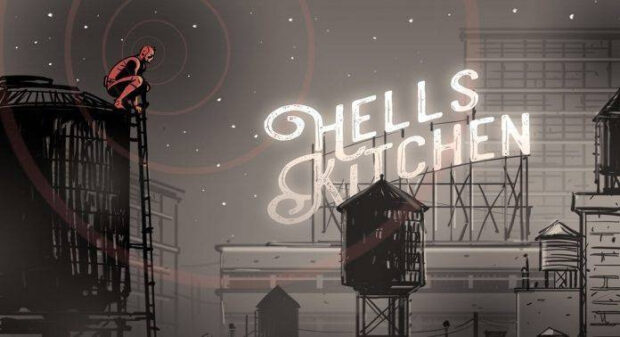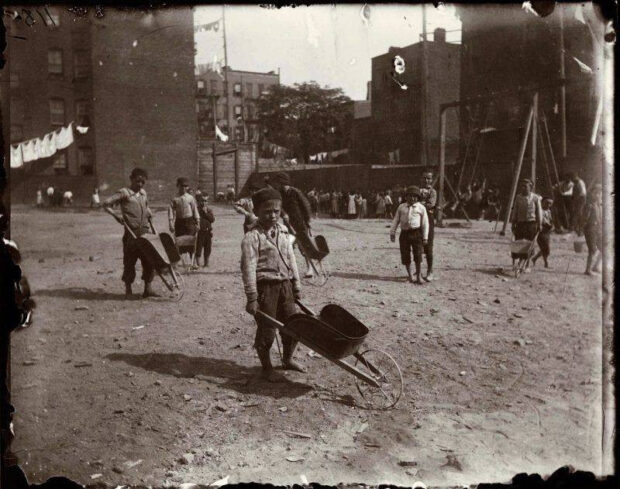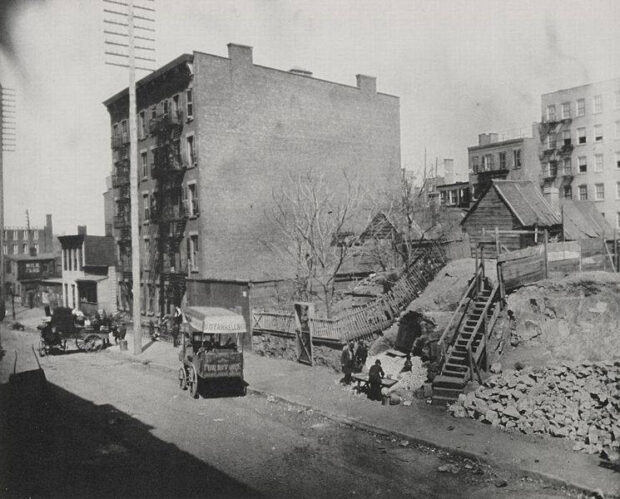
Can a big city area, which has been one of its criminal centers for almost 200 years, become the seat of a large number of expensive restaurants, theatres, and luxury apartment buildings? If it’s New York, of course. This was the route from 34th Street to 59th Street in Manhattan and 8th Avenue to the Hudson River called Hell’s Kitchen.
The period from 1845 to 1849 in the history of Ireland is called «The Great Famine». On the one hand to it «colonization» of the country by the British, because of which the native inhabitants practically lost their land. Peasants were saved by growing potatoes (hence the nickname «potato skeletons»), but in those years he was struck by photopheresis. Ireland’s population was eventually reduced by 30 percent, with about 1 million people starving to death and another 1.5 million leaving the country.
In the winter of 1848, four ships arrived in New York City with 1,000 Irish immigrants. They were so exhausted, they fell under the weight of their outer clothing and backpacks. Half-dead Irishmen were sent to Manhattan by Mayor William Havemeyer. They were given one of the poorest districts, which received the name «swamp» from local residents. The area was in a low plain, where the rain dried almost from all of New York City. Tuberculosis was one of the most common diseases among the people living there.

The Irish occupied half-demolished houses abandoned by the former inhabitants for demolition. However, even this type of housing did not suffice for all – the rest settled in hastily made-up huts. The city provided humanitarian aid, but it was insufficient. Within a few months, about 20 percent of immigrants died of hunger and cold.
A medical report was found on the condition of foreign migrants:
«I have not seen anything like it in my life. Either these people were starved or they suffer from some rare disease.»
The Havemeyer was accused of deliberately starving the sick and incapacitated Irish. The mayor replied that the deaths were not caused by hunger. He allegedly saw firsthand during a tour of the campfire, where immigrants brewed fragrant meat soup. Historians disagree on whether Havemeyer actually said such words. However, many believe that the name Hell’s Kitchen District came after this speech.

Before the Irish, the area was inhabited mostly by Germans and Dutch. The feud between them continued, with dead people found in the streets every day. The most common murder weapon was a ceramic beer mug from the nearest pub.
Georg Staffe, the owner of one of the drinking establishments, once said:
«The establishment starts to generate income only when there is nothing left to break or break».
Another bar owner by the name of Pete Van Geer just started pouring alcoholic beverages into wooden mugs chained to him. He had enough money to hire a bouncer armed with metal bars. Such measures were most often saved from fights and killings, but when a riot was planned, not even big guns could help.
READ: Top 6: New York’s Best High School
With the arrival of settlers from Ireland, life in the area became even more dangerous. In the 1860s, up to 100 people were killed in Hell’s Kitchen every day. The reasons were mostly domestic – life was lost by drunken scandals, adulterous spouses and overdue debtors.
In the 1870s, the area was filled with numerous restaurants that worked in the cellars of the houses. In winter, thick smoke was poured from the small windows of their kitchens. This is another possible reason for the appearance of a strange place name.
To the already mentioned nationalities in Hell’s Kitchen were added Italian mafiosi fiercely fighting for the expansion of their own living space. It is migrants from Italy who are obliged by the new nickname «concrete cemetery» of the disadvantaged district «Big apple». Italian gangsters liked to roll their enemies into concrete.
One day, 16 bodies were found in the basement of Luca Benacio’s restaurant. Luca had his own handwriting: he invited a detractor to a dinner party, and then killed the attacker in cold blood with a shot to the head during a meal. And the body would go into the basement and roll into the concrete.
The Italians were followed by youth gangs in the area. Gofer’s gang became famous among them. In 1903, it was known throughout New York City, with about 500 members of the group stealing from stores, robbing people, racketeering, and commission killings. The most popular members of the gang were Al Bernardino (a bank robber) and Charles Hoffman (a murderous killer of police officers and other law enforcement agents).
Over time, their activities expanded from a simple band of immoral characters to the Gofer gang, which became a powerful force in restaurants, bars, and other establishments, as well as in the funeral business.
By 1920, almost all businesses in Hell’s Kitchen were controlled by Cosa Nostra. Because of this, the area was distinctly different – there was practically no drug trafficking in it. Anyone who tried to sell drugs here was quickly killed by the mob or the police. And the bodies of the trash salesmen were on display, hanging them on trees and lights, so over time, they were afraid to sell drugs in Hell’s Kitchen.
In the late 1940s, Hell’s Kitchen was once again flooded with immigrants, now from Puerto Rico. To adapt to local rules, they also organized themselves into gangs and feuded with others. From the area were such well-known criminal elements as Vincent «Mad Dog» Call, Bill Dwyer, Owney Madden, Jimmy Coonan, Mickey Fitherstone, Eddie McGrath, Mickey Spillana, Eddie «Butcher» Kamisky. Al Capone himself was a regular in Hell’s Kitchen, her mores were to his liking, and he regularly compared the dangerous New York area to Chicago.
Another nickname of the district was found in the 1950s – «the area of stone beaches». The criminal elite developed a new kind of entertainment for people – the organization of swimming pools and cocktail bars directly on the roofs of high-rise houses during hot sunny days. The business generated substantial revenue until Mayor Robert Wagner banned it. The reason was simple – too many people fell down from roofs.
READ Good Tourism Rules or What NOT to DO When You Come to New York City
In 1957, the premiere of the musical «West Side History» – modern transfer of Romeo and Juliet took place. The main characters of the work were from rival gangs of Irish and Puerto Ricans.
In the mid-1960s, the mores of Hell’s Kitchen changed – to the «authority» here came the Irish gang Westies. Unlike the Italians, the new masters were not immune to the drug trade. At the time, the authorities gave the area the official name Clinton, but the sonorous nickname Hell’s Kitchen is much more common today.
In the late 1980s, Rudolph Giuliani, who was then a district attorney, took down a criminal in Hell’s Kitchen. He imprisoned Irish gang leaders, closed down bars where criminals gathered, and ended prostitution, depriving the mob of an important source of money.
The economic recovery of the region was the result of the competent actions of the authorities. It turned out that the Hell’s Kitchen built on the swamp had quite a good location – next to it is Midtown, the business and cultural center of New York City. So the area became an attractive place for businessmen, actors, musicians and other high-class people. It changed him forever, but the stormy history of the place is still told by his whiny and uncomfortable nickname, statistically defiantly unpleasant association in 40% of US residents.
James Dean, Marilyn Monroe, Sylvester Stallone, James Gandolfini, Al Pacino, Edward Norton, John Goodman, Bruce Willis, Tom Hanks, Robert De Niro, Madonna and Alicia Keys – all these celebrities counted and consider once «Hell’s Kitchen» their home, which is why they call it little Hollywood.
READ The Best Universities of New York
And the main attractions became not places where bandits run, but «restaurant row» – more than 20 establishments offering cuisine from all over the world; Windermere building – multi-storey building, built more than 150 years ago and offering the city’s guests expensive hotel rooms; and World Wide Plaza is a business and residential skyscraper. But one thing has remained unchanged since the dark days of Hell’s Kitchen – a thriving sex industry. At the very least, it’s full of seksshop, and you’ll find out about other kinds of sex industry.
Of course, the name Hell’s Kitchen doesn’t help sell real estate in the area. So the names Clinton and Midtown West became more familiar and pleasant.
Like us on Facebook for more stories like this: